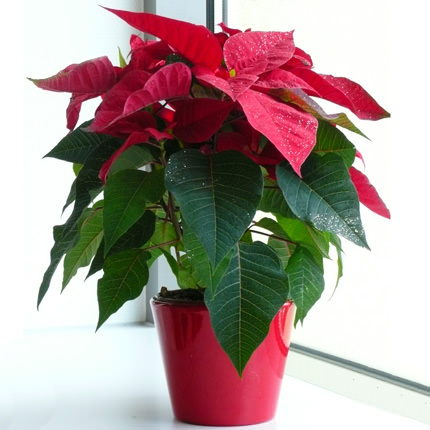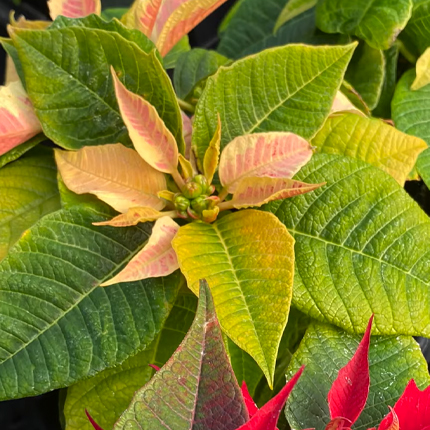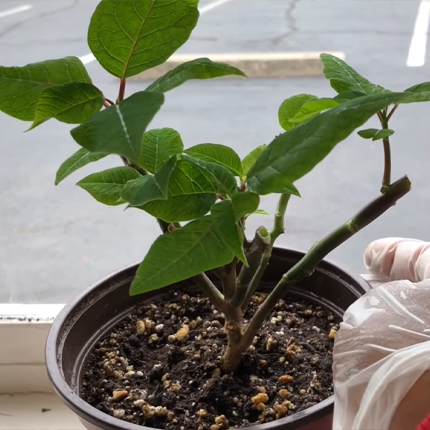Poinsettia: Growing, Propagation, and Care at Home
Poinsettias are scarlet, pink, or white decorative plants in pots, which are also called the Christmas Star or Bethlehem Star, as they bloom just in time for the Christmas holidays. Poinsettia cannot go unnoticed; the plant looks very spectacular, original, and undemanding. If you are looking for original flowers in Dnipro, check out our catalog, and you will find many unusual compositions.
Poinsettia in Detail

Poinsettia (Indoor Plant)
The “prettiest spurge” (Euphorbia pulcherrima), or Poinsettia, belongs to the Euphorbia genus. In a natural environment, the plant grows in the tropics of Latin America. The shrub received its name in honor of J. R. Poinsett, an American politician who is remembered for being the first U.S. agent in South America. Poinsett was interested in botany and first brought Euphorbia pulcherrima from Mexico to the States in 1825.
By its nature, the plant is an evergreen shrub, which in its native areas can grow up to 4 m (~13 ft.) in height. The cultured species grow up to a maximum of 30-50 cm (~1-1.6 ft.). The leaves of the species are dark, 10-15 cm (~0.3-0.5 ft.) long, oval in shape, with a gear edging, growing on small petioles. In the flowering season, inflorescences with small light yellow buds surrounded by bright red bracts are blossoming at the tops of shoots. Inexperienced gardeners often confuse these bracts with the real flowering of the Christmas Star. Today, thanks to the work of scientists, you can find poinsettia not only with scarlet, but also with yellow, pink, snow-white, and even two-tone bracts, which gives you plenty of choice.
Poinsettia Varieties

- Sonora Marble. A plant with pale cream bracts and pink inclusion in the center.
- Winter Blush Marble. This variety is characterized by the non-standard color of the leaves. The top is light pink with beige edging, and the bracts are of a warm light green shade.
- Strawberry and Cream. Light milk bracts pass into the leaves with a coral subtone.
- Da Vinci. Highly decorative variety with pink bracts.
- Monet Twilight. Bracts of the ivory color with a blurry pink subtone and bright red strokes.
- Tapestry. This plant has attractive heart-shaped leaves in a bright scarlet color.
- Lemon Snow. Poinsettia with light lemon-colored inflorescences.
- Cinnamon Star. A multi-colored shrub with an orange upper bract, which smoothly passes into the bright yellow lower one with green strokes at the edges. The leaf plates have gear edges.
- Orange Poincettias. The elongated leaf plates of this variety come in a bright coral color.
- Yellow Poincettias. The variety with pale olive leaves.
- Euphorbia Pulcherrima. A shrub with two-tone tiers: the upper is bright yellow, smoothly passing into the orange-scarlet one.
- White Star. The extended sharp leaf plates of this variety come in a pearl-white tint. The shrub is fluffy, which makes it decorative.
- Polar Bear. The bracts are white or yellow with a greenish tint.
- Arctic White. The bright green foliage of this shrub contrasts with a snow-white bract at the top.
- Carousel Red. The inflorescences come in bright red color; the edges of the bracts are wavy.
- Carousel Dark Red. This variety is very reminiscent of Carousel Red in its appearance, but the color of the inflorescence is dark red.
- Premium Red. This is the most popular variety with a rich-red bract in the center. The flowers are small and yellow.
- Cortez Burgundy. The plant with a crimson crown and heart-shaped leaf plates.
- Blue Poinsettia. A plant of amazing beauty; the bracts are saturated blue, and the leaves are bright green with dark green stripes.
- Strawberry and Cream. The bracts are similar to maple leaves in shape and come in a peach color with a cream spot in the middle.
Growing Poinsettia

Most often, poinsettia is bought in specialized stores in a blooming form and given for Christmas. In the future, when the plant stops blooming, it loses its former attractiveness and often even dies. However, if you provide the right conditions for growing and care, the plant will bloom on the Christmas holidays annually.
The basic rules for cultivating poinsettia are simple:
- When the foliage begins to fall, the volume and frequency of watering decrease to such an extent that the soil mixture remains almost dry. The introduction of top dressing is also suspended. Additionally, you need to cut the shrub so that there are approximately 15-20 cm (~0.5-0.7 ft.) from the surface. After such preparation, the pot with poinsettia is transferred to the room similar to a basement and kept there until the end of spring.
- With the advent of May, it is necessary to transfer the flower to a sunny spot, resume watering and fertilization with mineral compositions. As soon as the Christmas Star completes the rest period and begins to grow, it must be transplanted into a new soil mixture.
- In the end of September, the shrub must be packaged in a dense box that will block the access of ultraviolet radiation. If there is no box, a shelf in the closet will do fine. Poinsettia should stay at least 14 hours a day in a dark place. The budding will occur more actively in such conditions.
- As soon as colorful bracts start to bloom on poinsettia, resume the standard care routine. When growing the Christmas Star, it must be remembered that the milky sap of the plant is toxic. The most vulnerable to poison are the mucous membranes of the eyes and nose. Moreover, the sap can cause irritation and redness on the skin in some cases. If it enters the esophagus, the toxin will cause nausea and vomiting. Given this, all work with the plant should be carried out only with protective gloves and preferably with glasses. You should also know that all euphorbia are toxic, but the care for different genus members varies.
Propagation of Poinsettia

In its natural environment, the Christmas Star reproduces by seed. However, at home poinsettia, like all types of peperomia, is usually propagated vegetatively, namely by cuttings. It is customary to cut the branches (with at least 4, preferably 6 buds) in early June. Their length should be 7-10 cm (~0.2-0.3 ft.). The segments must be cut immediately below the knot. After that, the branches are placed in a glass of water at room temperature with the cut part down for the toxin to flow out. Then they are dried, and the sections of the cuts are treated with a root growth stimulator. Next, you can proceed directly to planting the cuttings in containers with a pre-prepared and moistened substrate (a mixture of river sand, manure, and humus).
It is necessary to store the cuttings in a bright and warm place (25-27°C / 77-80.6°F), covered with glass or polyethylene and protected from direct sunlight. From time to time, the barrier needs to be slightly opened to remove condensate and irrigate the branches. After about a month, the cuttings will take root; now the pots can be moved to a cool place with a temperature of 16°C (~0.5 ft.), and not lower. With the advent of autumn, the young poinsettias will already be strong enough to develop in separate pots. Choose containers with a diameter of 17-20 cm (~0.6-0.7 ft.). The very next year, the Christmas Stars will become attractive and bloom.
Poinsettia Care
To successfully grow the Christmas Star indoors, you need to follow a number of specific rules. In general, caring for poinsettias, like caring for bacopa and other ornamental potted plants, is not difficult.
Placement and Lighting

It is recommended to grow the Christmas Star on the windowsills facing east or west. Keep in mind that the plant doesn’t like drafts and targeted sunrays at all. During the period of bud formation, the temperature in the room with poinsettia should be at the level of 18-25°C (64.4-77°F), during flowering: 15-16°C (59-60.8°F), and during wintering: 12-14°C (53.6-57.2°F). In summer, the flower pot can be taken out to the balcony – or you can simply ventilate the room more often. However, drafts must be excluded; otherwise the plant will begin to shed its leaves. If your house or apartment is quite warm all year round, airing should be systematic regardless of the season. In the first half of autumn, the plant needs only 12 hours of daylight. To maintain these conditions, it should be carefully covered with a dark cloth or cardboard box for 14 hours every day for two months. The budding will go faster and the bracts will begin to fill with a bright color even more actively.
Pot Selection
A well-chosen pot is a very important factor when growing any houseplant, and poinsettia is no exception. First you need to decide on the material; ceramics or plastic are preferable for this flower. As for the dimensions, they should be such that the rhizome, together with the earthy clod, fits freely – but not too much, or the shrub will begin to develop the root instead of the green mass.
Soil
Poinsettias love the airy and fertile soil. The most optimal substrate is a mixture of lowland peat, soddy, leafy soil, and river sand in equal parts. The acidity level should be neutral or slightly acidic.
Watering

The Christmas Star requires generous watering. However, before you start with it, you must definitely check the condition of the soil in the pot: its top layer should dry out, but not crack into pieces. Use water at room temperature, preferably a little warmed up, for moisturizing. If the shrub feels cold moisture, its foliage may begin to fall off. Additionally, don’t forget to drain the remaining water from the pan in time. Any stagnant water near the rhizome can lead to root rot.
Air Humidity
Poinsettias are tropical plants that are used to high humidity. It is necessary to create indoor conditions that are close to natural. Spray water into the air next to the shrub twice a day or place a humidifier near the pot. Try to avoid getting drops on the leaf plates, or else the stains may form. The hydration of poinsettia is suspended for the duration of the dormant period. When the heat comes and the shrub starts to grow, the procedure can be resumed. Further spraying is carried out depending on the microclimate in the room: if it is too hot, moistening is increased, and if it is cool, vice versa.
Top Dressing
It is customary to fertilize poinsettia in spring, summer, and autumn with an interval of once every two weeks, using universal mineral dressings. With the onset of the flowering season, the shrub will need supplements with high potassium content. However, many flower growers don’t fertilize the plant at all during flowering.
Crown Formation

To facilitate bud growth, poinsettia is cut in half immediately after the flowering season, leaving only about 4-5 points of growth, and transferred to a dry room with a temperature not exceeding 15°C (59°F). During this season, which lasts about two months, the plant is not watered or watered very rarely. Around the end of spring, the weak young branches should be cut off from the shrub, leaving only 5-6 strong and promising ones. Then the shrub is transplanted into a larger pot and placed in a sun-filled room. From this moment on, the systematic watering is resumed; at the same time don’t forget to cut the too long shoots on occasion, and do this until the end of summer. After such pruning, the crown of poinsettia will become more voluminous and more abundant in bloom. In August, the buds begin to grow; the pruning of the shrub is suspended for this period.
Transplanting
Poinsettia is transplanted in the second half of spring. Focus on the end of hibernation period; at this time the new leaves are just beginning to grow. The soil mixture for transplanting should be as follows: clay, leaf soil, turf, and river sand in a ratio of 3:2:1:1. There must be good drainage at the bottom of the container. As for the choice of pot, it should not be much larger than before. The shrub is transplanted by transshipment.
Flowering
The Christmas Star is often bought blooming, but not everyone knows how to properly care for the plant after the flowering has ended. In this case, the main goal is to provide it with optimal conditions before hibernation. At the end of winter, when the bracts wither, the shoots must be cut so that 10-15 cm (~0.3-0.5 ft.) remain from the shrub. Watering amounts are reduced to almost zero. Moisturize the shrub during the dormant period only if the leaves begin to sag. From mid-April, the stems and young foliage begin to grow rapidly. When this happens, move the pot to a brightly lit room and resume regular watering. If you want your beauty to bloom for Christmas, provide the plant with 14 hours of darkness when autumn arrives. If everything goes right, buds will begin to grow on the shrub in December; then the cover can be removed for good. Additionally, the shrub can be placed on the windowsill, but in a way to avoid drafts. With the onset of budding, all green foliage growing around the flowers will quickly begin to “dress up” in bright colors.
Post-Flowering Care

The dormant season for the plant starts in March or April and lasts about a month and a half. When the leaves begin to fall down from the shrub, the shoots are cut off, leaving only 15 cm (~0.5 ft.) from the ground level. After that, poinsettia is moved to a cool and shaded spot. Try not to disturb the plant during hibernation, letting it rest and gain strength. At the end of spring, the rest period will end and it will be possible to return to normal care.
Diseases and Pests
The Christmas Star has a fairly strong immune system, although it is quite demanding and capricious.
Pests
Most often, the shrub is invaded by thrips, aphids, whiteflies, scale insects, mealybugs and spider mites. A sign of the vital activity of worms is a whitish coating; aphids and whiteflies leave behind sticky blotches on the leaves. You can drive away the parasites with folk methods (for example, by rubbing the leaves with tobacco infusion or a solution of liquid soap) or by applying systemic insecticides. Mineral oil has proven to be an effective remedy for worms. However, fungicides are indispensable in case of a mass infestation. Cobweb colonies are also removed by chemistry (acaricides and fungicides).
Diseases
Fusarium, gray rot, and powdery mildew are the diseases that can affect poinsettia most often. Gray rot develops in conditions of excessively high humidity. Signs of the disease are gray plaques on inflorescences, shoots, and leaves. At the initial stage, the disease is treated by rubbing the shrub with celandine, and in neglected cases, by treating it with fungicides. The outcome of Fusarium is dark brown shoots and stems, which subsequently die off. Powdery mildew is accompanied by a white coating, which darkens later. All diseases caused by fungal infections are treated with broad-spectrum fungicides. If necessary, the shrub is treated with chemicals twice, with an interval of a week or two.
Possible Issues

- Yellowing of the foliage. If poinsettia stays in a cool room, and at the same time moisture regularly stagnates in the soil, then rot develops on the rhizome, and the leaf plates begin to turn yellow. Low air humidity can also cause the leaves to turn yellow. A weakened shrub is immediately attacked by pests.
- Leaves falling off. Most often, this happens due to excessively low air humidity or due to the stagnation of fluid in the soil in cool conditions. The process begins with yellowing, and the leaves fall off after that. A similar phenomenon can also occur due to insufficient watering, poor lighting, or unforeseen temperature fluctuations. Don’t worry if the leaves fall off in the second half of January; poinsettia is preparing for a dormant period at this time.
- The stipules of the flower don’t turn red. This can happen for many reasons, but the most common one is wrong care in the autumn. The shrub needs to be provided with complete 14-hour darkness per day already with the onset of September so that the plant can grow new buds.
- Poinsettia dries up. If the shoots have begun to dry, immediately check the state of the root system. If everything is in order, transplant the shrub into a new substrate, cut the dried stems up to the healthy tissue, and treat the cuts with crushed coal. While poinsettia is recovering, it must be placed in a cool spot with partial shade. Abundant watering is not required at this time. When the plant goes back to life, the pot can be returned to a place with good lighting; slowly begin to restore the usual watering and fertilizing schedule. Always drain the remaining water from the pallet; otherwise the root system of the shrub will suffer.
Poinsettia Magic

The Christmas Star is a houseplant with positive energy. For everyone who doesn’t have an allergic reaction, it is quite possible to grow the shrub in a house or apartment.
Poinsettia has a lot of valuable qualities:
- Gives peace and understanding to all family members
- Helps develop intelligence and promotes the rapid assimilation of new information
- Helps to quickly get rid of respiratory diseases
- Improves the mood and promotes positivity
- Increases work motivation
- Relieves stress and reduces anxiety
- Normalizes appetite
- Contributes to success in financial affairs
- Serves as a talisman against the envious and ill-wishers.
